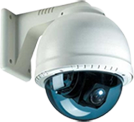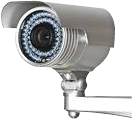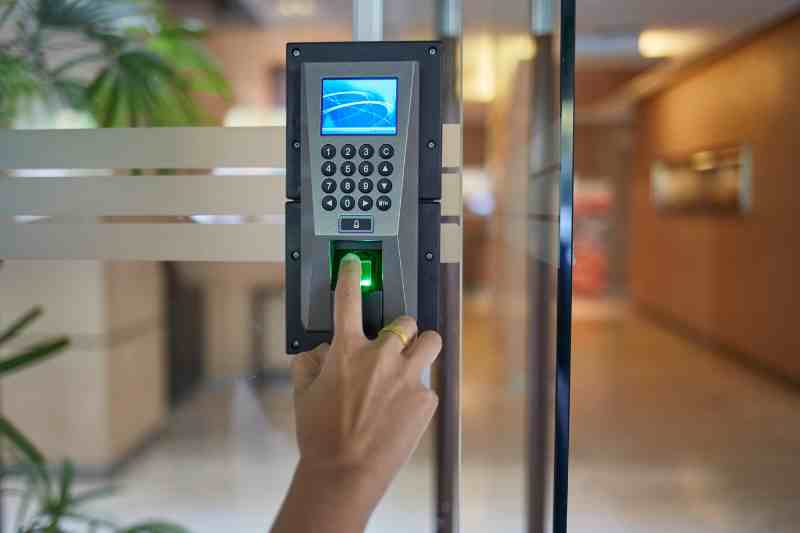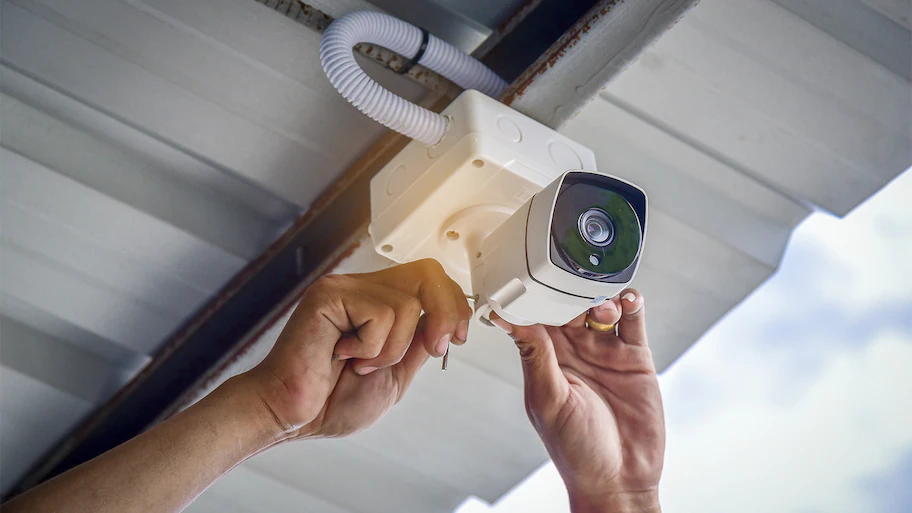In Security sytems
We're talking about home security systems, which are networks of integrated electronic devices working together with a central control panel
Fingerprint Biometrics
A fingerprint is made of a a number of ridges and valleys on the surface of the finger. Ridges are the upper skin layer segments of the finger and valleys are the lower segments. The ridges form so-called minutia points: ridge endings (where a ridge end) and ridge bifurcations (where a ridge splits in two). Many types of minutiae exist, including dots (very small ridges), islands (ridges slightly longer than dots, occupying a middle space between two temporarily divergent ridges), ponds or lakes (empty spaces between two temporarily divergent ridges), spurs (a notch protruding from a ridge), bridges (small ridges joining two longer adjacent ridges), and crossovers (two ridges which cross each other). The uniqueness of a fingerprint can be determined by the pattern of ridges and furrows as well as the minutiae points. There are five basic fingerprint patterns: arch, tented arch, left loop, right loop and whorl. Loops make up 60% of all fingerprints, whorls account for 30%, and arches for 10%. Fingerprints are usually considered to be unique, with no two fingers having the exact same dermal ridge characteristics.
How does fingerprint biometrics work
The main technologies used to capture the fingerprint image with sufficient detail are optical, silicon, and ultrasound. There are two main algorithm families to recognize fingerprints:
- Minutia matching compares specific details within the fingerprint ridges. At registration (also called enrollment), the minutia points are located, together with their relative positions to each other and their directions. At the matching stage, the fingerprint image is processed to extract its minutia points, which are then compared with the registered template.
- Pattern matching compares the overall characteristics of the fingerprints, not only individual points. Fingerprint characteristics can include sub-areas of certain interest including ridge thickness, curvature, or density. During enrollment, small sections of the fingerprint and their relative distances are extracted from the fingerprint. Areas of interest are the area around a minutia point, areas with low curvature radius, and areas with unusual combinations of ridges.
Issues with fingerprint systems
The tip of the finger is a small area from which to take measurements, and ridge patterns can be affected by cuts, dirt, or even wear and tear. Acquiring high-quality images of distinctive fingerprint ridges and minutiae is complicated task. People with no or few minutia points (surgeons as they often wash their hands with strong detergents, builders, people with special skin conditions) cannot enroll or use the system. The number of minutia points can be a limiting factor for security of the algorithm. Results can also be confused by false minutia points (areas of obfuscation that appear due to low-quality enrollment, imaging, or fingerprint ridge detail). Note: There is some controversy over the uniqueness of fingerprints. The quality of partial prints is however the limiting factor. As the number of defining points of the fingerprint become smaller, the degree of certainty of identity declines. There have been a few well-documented cases of people being wrongly accused on the basis of partial fingerprints.
Benefits of fingerprint biometric systems
- Easy to use
- Cheap
- Small size
- Low power
- Non-intrusive
- Large database already available
Applications of fingerprint biometrics
Fingerprint sensors are best for devices such as cell phones, USB flash drives, notebook computers and other applications where price, size, cost and low power are key requirements. Fingerprint biometric systems are also used for law enforcement, background searches to screen job applicants, healthcare and welfare.
Fingerprint Identification Systems
|
Fingerprint Recognition:
Strengths
|
Fingerprint
Recognition:Considerations
|
|
Iris recognition: Strengths
|
Iris recognition: Considerations
|
|
Hand Geometry: Strengths
|
Hand Geometry: Considerations
|
|
Face Recognition: Strengths
|
Face Recognition: Considerations
|
| Technology Characteristic |
Fingerprint | Iris | Facial | Hand |
| How it works | Capture and compares fingertip s patterns | Captures and compares iris patterns | Captures and compares facial patterns | Measures and compare dimensions of hand and fingers |
| cost of device | Low | High | Moderate | Moderate |
| Enrollment time | About 3 minutes, 30 seconds |
2 minutes, 15 seconds | About 3 minutes | About 1 minute |
| Transaction timea | 9 to 19 seconds | 12 seconds | 10 seconds | 6 to 10 seconds |
| False nonmatch rateb | .2%-36% | 1.9%-6% | 3.3%-70% | 0%-5% |
| False match rate(FMR)c |
0%to8% | Less than 1% | 0.3%-5% | 0%-2.1% |
| User acceptance issues | Associated with law enforcement, hygiene concerns |
User resistance, usage difficulty |
Potential for privacy misuse | Hygiene concerns |
| factors affecting Performanced |
Dirty, dry or worn fingertips |
Poor eyesight, glare, or reflection | Lighting, Orientation of face and sunglasses | Hand injuries, arthritis, swelling |
| Demonstrated vulnerabilitye |
Artificial fingers, reactivated latent prints |
High-resolution picture of iris | Notebook computer with digital photographs | None |
| Variability with agesf | Stable | Stable | Affected by aging | Stable |
| Commercial availability since |
1970s | 1997 | 1990s | 1970s |
- (a) Amount of time it takes to verify machine-red biometric versus stored biometric.
- (b) The probability that individuals who should be matched are not matched by a biometrics system.
- (c) The probalility of an erroneous match in a singgle template comparison.
- (d) Human characteristics or measurement condition circumstances that could adversely affect accuracy of biometric systems.
- (e) Demonstrated methods of beating biometric systems that have benn employed in tests.
- (f) Effects of age, if any, of individual on his or her biometric identifiers
 Security cameras are of different types. One of them
is closed circuit television, popularly known as CCTV. CCTV cameras are in use since
1942. Security cameras represent best mode of surveillance and security. CCTV
cameras are no exception. They have become a common feature in many shopping
premises, corporate buildings, malls, multiplexes, and other important buildings.
Interestingly, they have also been used to monitor processes like nuclear fuel and
industrial manufacturing.
Security cameras are of different types. One of them
is closed circuit television, popularly known as CCTV. CCTV cameras are in use since
1942. Security cameras represent best mode of surveillance and security. CCTV
cameras are no exception. They have become a common feature in many shopping
premises, corporate buildings, malls, multiplexes, and other important buildings.
Interestingly, they have also been used to monitor processes like nuclear fuel and
industrial manufacturing.
 Now a day, CCTV cameras take photographs on a
continuous basis as well as when alerted by a motion detector. Set up has become
very easy and that has further increased its popularity. Additional feature of
storing images on computers from CCTV cameras has made these cameras even more
appealing. CCTV cameras are available in low as well as high end segment. One can
opt for his preferred CCTV cameras based on his requirements.
Now a day, CCTV cameras take photographs on a
continuous basis as well as when alerted by a motion detector. Set up has become
very easy and that has further increased its popularity. Additional feature of
storing images on computers from CCTV cameras has made these cameras even more
appealing. CCTV cameras are available in low as well as high end segment. One can
opt for his preferred CCTV cameras based on his requirements.





